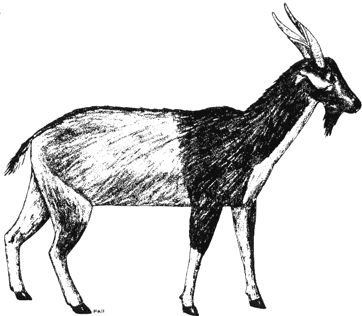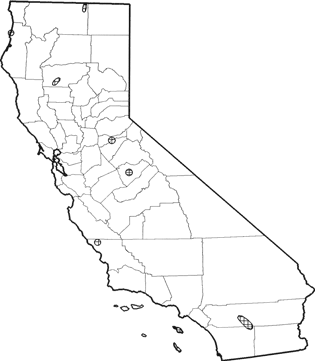
Feral Goat
Distribution, Abundance, and Seasonality
Feral goats are locally abundant in a few scattered locations in California. Isolated populations are found in foothill and coastal habitats from the Oregon border to San Diego Co., and on Santa Catalina Island. Habitats used include valley foothill hardwood and valley foothill hardwood-conifer, valley foothill riparian, mixed chaparral, coastal scrub, and annual grassland.

Range Map
Specific Habitat Requirements
Feeding: Goats feed on grasses, forbs, and browse. In some studies, virtually every plant species present is used (Coblentz 1977). Goats tend to feed on the most palatable and nutritious forage available, yet they can survive on extremely poor-quality forage (Coblentz 1977, Green et al. 1978, Green and Newell 1982). Grasses and forbs are preferred, but can subsist entirely on browse, as they do on overgrazed range (Coblentz 1977). If a preferred food species is scarce, goats may eradicate it (Coblentz 1977).
Cover: Steep, rocky slopes are preferred for escape from predators and for bedding grounds, the location of which is traditional (Coblentz 1976). Goats return to bedding grounds after a day of foraging in other habitats.
Reproduction: Breed in rugged, steep slopes, rock outcrops, or cliffs.
Water: No data found.
Pattern: Goats are generalists, grazing and browsing in a variety of habitats: valley foothill woodland, coastal scrub, chaparral, and annual grasslands. Graze when grasses and forbs are available in spring and summer; browse when grasses and forbs are unavailable. Use rocky areas for cover.
Species Life History
Activity Patterns: Active yearlong; primarily diurnal.
Seasonal Movements / Migration: None.
Home Range: Goats usually found in herds of 5-20, though herds sometimes may number up to 100. Herds may consist of all males, mixed sex and age groups, or females and young. Members of a herd usually scattered over home range at any particular time as single individuals, or in small groups. Herds have home ranges of about 2.5-5.0 km? (1-2 mi?) on Santa Catalina Island (Coblentz 1976). Densities reached 400/km? (1000/mi?) on Macauley Island, New Zealand (Nowak and Paradiso 1983).
Territory: Herds usually do not overlap. Home range is not defended. Males fight for access to estrous females.
Reproduction: Most conceptions occur August-January, peaking in October-November. Dominant males may copulate with several females. At times, so many males attempt to mate with 1 female that no single male is able to retain control of mating, and a seemingly chaotic interaction results. Gestation period 147-155 days, averaging about 151 days. One to 3 precocial young are born, averaging 2. Sexual maturity is reached in the first yr (Asdell 1964).
Niche: Goats can be highly destructive to natural vegetation, and have contributed to erosion, the spread of deserts, and the disappearance of wildlife in Middle East and Mediterranean areas, Hawaiian Islands, and other island locations. In some cases, areas may be left devoid of vegetation, or in early successional stages. Goats will compete with black-tailed deer. In some areas, have been used to control dense brush (Coblentz 1977, Green et al. 1978, Green and Newell 1982). Such use must be controlled carefully, to keep the goats from eating unintended plant species. Potential predators are mountain lions, coyotes, bobcats, and domestic dogs.
Sources & References
California Department of Fish and Game, 1999.
California's Wildlife, Sacramento, CA.
Written by: R. A. Hopkins, reviewed by: H. Shellhammer, edited by: J. Harris, R. Duke
Asdell, S. A. 1964. Patterns of mammalian reproduction. 2nd ed. Cornell Univ. Press, Ithaca, Ny. 670pp. Coblentz, B. E. 1976. Wild goats of Santa Catalina. Nat. Hist. 85:70-77. Coblentz, B. E. 1977. Some range relationships of feral goats on Santa Catalina Island, California. J. Range Manage. 30:415-419. Green, L. R., and L. A. Newell. 1982. Using goats to control brush regrowth on fuelbreaks. Pac. Southwest For. and Range Exp. Sta. Gen. Tech. Rep. PSW-59. 13pp. Green, L. R., C. L. Hughes, and W. L. Graves. 1978. Goat control of brush regrowth on southern California fuelbreaks. Pages 451-455 in D. N. Hyder, ed. Proceedings of the First international Rangeland Congress. Soc. for Range Manage., Denver, CO. 742pp. Nowak, R. M., and J. L. Paradiso. 1983. Walker's mammals of the world. 4th ed. 2 vols. John Hopkins Univ. Press, Baltimore, MD. 1362pp. Riney, T., and G. Caughley. 1959. A study of home range in a feral goat herd. New Zealand. J. Sci. 2:157-170. Shank, C. C. 1972. Some aspects of social behavior in a population of feral goats (Capra hircus L.). Z. Tierpsychol. 30:488-528.
California Animal Facts | California's Wildlife